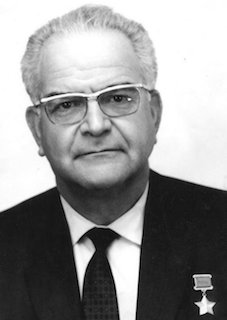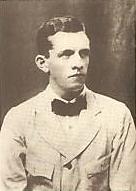
Lev Davidovich Bronstein, better known as Leon Trotsky, was a Russian revolutionary, Soviet politician, journalist, political theorist and founder of the Red Army. He was a central figure in the October Revolution, Russian Civil War, and the establishment of the Soviet Union. Alongside Vladimir Lenin, Trotsky was widely considered the most prominent Soviet figure and his de facto, second-in-command during the early years of the Russian Soviet Republic. Ideologically a Marxist and a Leninist, Trotsky's thought and writings inspired a school of Marxism known as Trotskyism.

The October Revolution, known in Soviet historiography as the Great October Socialist Revolution, was a revolution in Russia led by the Bolshevik Party of Vladimir Lenin that was a key moment in the larger Russian Revolution of 1917–1923. It was the second revolutionary change of government in Russia in 1917. It took place through an armed insurrection in Petrograd on 7 November 1917 [O.S. 25 October]. It was the precipitating event of the Russian Civil War.

The Russian Revolution was a period of political and social change in the Russian Empire, starting in 1917. This period saw Russia abolish its monarchy and adopt a socialist form of government following two successive revolutions and a bloody civil war. The Russian Revolution can also be seen as the precursor for the other European revolutions that occurred during or in the aftermath of World War I, such as the German Revolution of 1918–1919.

The Russian Civil War was a multi-party civil war in the former Russian Empire sparked by the overthrowing of the social-democratic Russian Provisional Government in the October Revolution, as many factions vied to determine Russia's political future. It resulted in the formation of the Russian Socialist Federative Soviet Republic and later the Union of Soviet Socialist Republics in most of its territory. Its finale marked the end of the Russian Revolution, which was one of the key events of the 20th century.

The ten years 1917–1927 saw a radical transformation of the Russian Empire into a socialist state, the Soviet Union. Soviet Russia covers 1917–1922 and Soviet Union covers the years 1922 to 1991. After the Russian Civil War (1917–1923), the Bolsheviks took control. They were dedicated to a version of Marxism developed by Vladimir Lenin. It promised the workers would rise, destroy capitalism, and create a socialist society under the leadership of the Communist Party of the Soviet Union. The awkward problem, regarding Marxist revolutionary theory, was the small proletariat, in an overwhelmingly peasant society with limited industry and a very small middle class. Following the February Revolution in 1917 that deposed Nicholas II of Russia, a short-lived provisional government gave way to Bolsheviks in the October Revolution. The Bolshevik Party was renamed the Russian Communist Party (RCP).

Ramón Mercader, was a Spanish Communist and NKVD secret agent who assassinated the revolutionary Leon Trotsky in Mexico City in August 1940. Mercader was imprisoned for 19 years and 8 months in Mexico for murdering the exiled Russian Communist with an ice axe.

Sidney George Reilly, known as the "Ace of Spies", was a Russian-born adventurer and secret agent employed by Scotland Yard's Special Branch and later by the Foreign Section of the British Secret Service Bureau, the precursor to the modern British Secret Intelligence Service (MI6/SIS). He is alleged to have spied for at least four different great powers, and documentary evidence indicates that he was involved in espionage activities in 1890s London among Russian émigré circles, in Manchuria on the eve of the Russo-Japanese War (1904–05), and in an abortive 1918 coup d'état against Vladimir Lenin's Bolshevik government in Moscow.

Fanny Efimovna Kaplan was a Russian Socialist-Revolutionary who attempted to assassinate Vladimir Lenin. She was arrested and executed by the Cheka in 1918.

Nadezhda Konstantinovna Krupskaya was a Russian revolutionary and the wife of Vladimir Lenin.

Yakov Mikhailovich Sverdlov was a Bolshevik Party administrator and chairman of the All-Russian Central Executive Committee from 1917 to 1919. He is sometimes regarded as the first head of state of the Soviet Union, although it was not established until 1922, three years after his death.

Grigori Yakovlevich Sokolnikov was a Russian Old Bolshevik revolutionary, economist, and Soviet politician.

Sir Robert Hamilton Bruce Lockhart, KCMG was a British diplomat, journalist, author, secret agent and footballer. His 1932 book Memoirs of a British Agent became an international bestseller and brought him to the world's attention by telling of his failed effort in 1918 to covertly back regime change in Revolutionary Russia, by assassinating Lenin as a prelude to a coup d'etat. After the plot failed, U.S. Consul General to Moscow and spymaster DeWitt Clinton Poole dissembled. It was said at the time that his main co-conspirator Sidney Reilly, and others were double agents working for the Bolsheviks. In the end, the "Lockhart Plot" was revealed as a cunning sting operation controlled by Felix Dzerzhinsky with the goal of discrediting the British and French governments. However, Boris Savinkov and in particular Xenophon Kalamatiano were working for the U.S. State Department under the direction of U.S. Secretary of State Robert Lansing, as pieced together in recent research by the historian Barnes Carr.

The July Days were a period of unrest in Petrograd, Russia, between 16–20 July [O.S. 3–7 July] 1917. It was characterised by spontaneous armed demonstrations by soldiers, sailors, and industrial workers engaged against the Russian Provisional Government. The demonstrations were angrier and more violent than those during the February Revolution months earlier.

Maria Ignatievna von Budberg-Bönninghausen — also known as Countess von Benckendorff and Baroness von Budberg — was a Russian adventuress and suspected double agent of the Soviet Union secret police (OGPU) and British Intelligence Service.

State of Revolution is a two act play by Robert Bolt, written in 1977. It deals with the Russian Revolution of 1917 and Civil War, the rise to power of Vladimir Lenin, and the struggles of his chief lieutenants – namely Joseph Stalin and Leon Trotsky – to gain power under Lenin in the chaos of the Revolution.
Censorship of images was widespread in the Soviet Union. Visual censorship was exploited in a political context, particularly during the political purges of Joseph Stalin, where the Soviet government attempted to erase some of the purged figures from Soviet history, and took measures which included altering images and destroying film. The USSR curtailed access to pornography, which was specifically prohibited by Soviet law.

Blood Red, Snow White is a historical novel by Marcus Sedgwick published in 2007. It is a novel set during the Russian Revolution, a fictionalised account of the time the author Arthur Ransome spent in Russia. It was shortlisted for the 2007 Costa Children's Book Award.
Joseph Stalin was the General Secretary of the Communist Party of the Soviet Union's Central Committee from 1922 until his death in 1953. In the years following Lenin's death in 1924, he rose to become the leader of the Soviet Union.

The All-Russian Congress of Soviets evolved from 1917 to become the supreme governing body of the Russian Soviet Federative Socialist Republic from 1918 until 1936, effectively. The 1918 Constitution of the Russian SFSR mandated that Congress shall convene at least twice a year, with the duties of defining the principles of the Soviet Constitution and ratifying peace treaties. The October Revolution ousted the provisional government of 1917, making the Congress of Soviets the sole, and supreme governing body. This Congress was not the same as the Congress of Soviets of the Soviet Union which governed the whole Soviet Union after its creation in 1922.

The Battle of Tsaritsyn was a military confrontation between the Red Army and the White Army during the Russian Civil War for control of Tsaritsyn, a significant city and port on the Volga River in southwestern Russia.


















